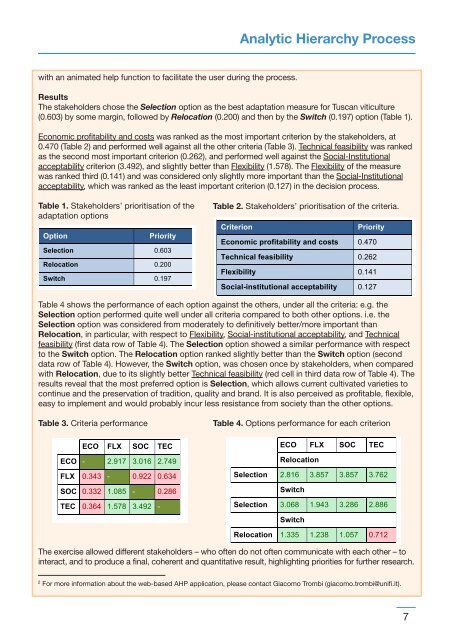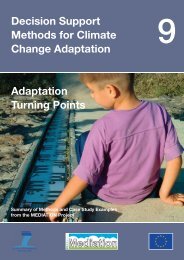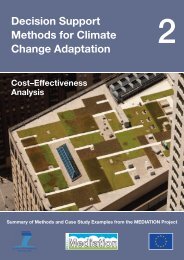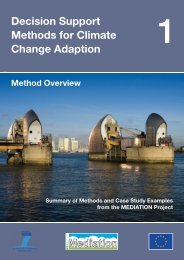Download all Technical Policy Briefing Notes in a single ... - Mediation
Download all Technical Policy Briefing Notes in a single ... - Mediation
Download all Technical Policy Briefing Notes in a single ... - Mediation
- No tags were found...
You also want an ePaper? Increase the reach of your titles
YUMPU automatically turns print PDFs into web optimized ePapers that Google loves.
Analytic Hierarchy Processwith an animated help function to facilitate the user dur<strong>in</strong>g the process.ResultsThe stakeholders chose the Selection option as the best adaptation measure for Tuscan viticulture(0.603) by some marg<strong>in</strong>, followed by Relocation (0.200) and then by the Switch (0.197) option (Table 1).Economic profitability and costs was ranked as the most important criterion by the stakeholders, at0.470 (Table 2) and performed well aga<strong>in</strong>st <strong>all</strong> the other criteria (Table 3). <strong>Technical</strong> feasibility was rankedas the second most important criterion (0.262), and performed well aga<strong>in</strong>st the Social-Institutionalacceptability criterion (3.492), and slightly better than Flexibility (1.578). The Flexibility of the measurewas ranked third (0.141) and was considered only slightly more important than the Social-Institutionalacceptability, which was ranked as the least important criterion (0.127) <strong>in</strong> the decision process.Table 1. Stakeholders’ prioritisation of theadaptation optionsOptionPrioritySelection 0.603Relocation 0.200Switch 0.197Table 2. Stakeholders’ prioritisation of the criteria.CriterionPriorityEconomic profitability and costs 0.470<strong>Technical</strong> feasibility 0.262Flexibility 0.141Social-<strong>in</strong>stitutional acceptability 0.127Table 4 shows the performance of each option aga<strong>in</strong>st the others, under <strong>all</strong> the criteria: e.g. theSelection option performed quite well under <strong>all</strong> criteria compared to both other options. i.e. theSelection option was considered from moderately to def<strong>in</strong>itively better/more important thanRelocation, <strong>in</strong> particular, with respect to Flexibility, Social-<strong>in</strong>stitutional acceptability, and <strong>Technical</strong>feasibility (first data row of Table 4). The Selection option showed a similar performance with respectto the Switch option. The Relocation option ranked slightly better than the Switch option (seconddata row of Table 4). However, the Switch option, was chosen once by stakeholders, when comparedwith Relocation, due to its slightly better <strong>Technical</strong> feasibility (red cell <strong>in</strong> third data row of Table 4). Theresults reveal that the most preferred option is Selection, which <strong>all</strong>ows current cultivated varieties tocont<strong>in</strong>ue and the preservation of tradition, quality and brand. It is also perceived as profitable, flexible,easy to implement and would probably <strong>in</strong>cur less resistance from society than the other options.Table 3. Criteria performanceECO FLX SOC TECECO - 2.917 3.016 2.749FLX 0.343 - 0.922 0.634SOC 0.332 1.085 - 0.286TEC 0.364 1.578 3.492 -Table 4. Options performance for each criterionECO FLX SOC TECRelocationSelection 2.816 3.857 3.857 3.762SwitchSelection 3.068 1.943 3.286 2.886SwitchRelocation 1.335 1.238 1.057 0.712The exercise <strong>all</strong>owed different stakeholders – who often do not often communicate with each other – to<strong>in</strong>teract, and to produce a f<strong>in</strong>al, coherent and quantitative result, highlight<strong>in</strong>g priorities for further research.2For more <strong>in</strong>formation about the web-based AHP application, please contact Giacomo Trombi (giacomo.trombi@unifi.it).7





